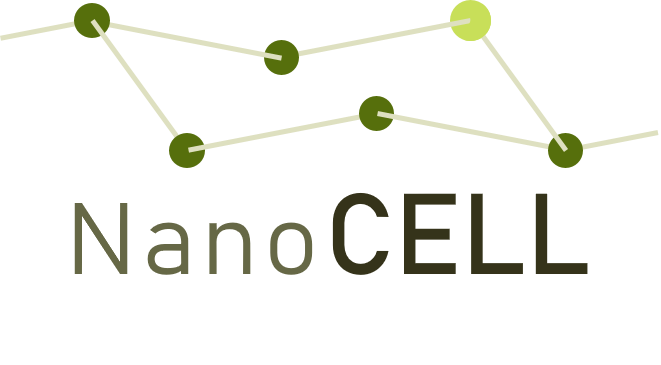
NanoCELL – Comprehensive characterization and human toxicological assessment of nanocellulose along its life cycle for reliable risk assessment and safe use in environmentally friendly packaging materials
Project report
The NanoCELL project addressed the synthesis, physico-chemical characterization, application, and human-toxicological assessment of nanocellulose across its life cycle. Particular focus was on crystalline nanocellulose (CNC) and its application in environmentally friendly packaging materials as important building block of a modern circular economy.
The most important developments and findings within NanoCELL are:
- Development of a process for the lab-scale synthesis of hydrophilic CNC from different raw materials (a.o., cotton, birch, spruce) including successful CNC spray-drying; upscaling of the CNC synthesis process requires adaptations of the reactor design though.
- Successful surface functionalization of CNC (fluorescence labelling, silanization).
- Successful coating of different foil substrates (Polylactic acid, polypropylene, paper) with high composite adhesion and improved barrier effect against oxygen but need further studies necessary regarding coating reproducibility and barrier effect against mineral oils.
- Comprehensive physico-chemical characterization of CNC (size/number distribution, Zeta potential, agglomeration) in complex matrices (a.o., cell culture medium, digestive juices) by multi-detector field-flow fractionation (FFF) and electron microscopy.
- Successful development of different in vitro (GIT-model, 3D lung models) and ex vivo (porcine mucus, intestinal tissue) to study potentially toxic effects of CNC after oral and pulmonal exposure.
- CNC-transport studies in in vitro and ex vivo models under static and dynamic conditions show CNC-transport across the mucus layer, but not across the intestinal tissue; no toxic effects could be observed under these conditions.
- Successful preliminary work for an in silico transport model for CNC across biological barriers.
Grant Number: BMBF - 03XP0196
Duration: 01.03.2019 - 28.02.2022 (extended to 30.06.2022)
Project Lead

Dr. Florian Meier, Postnova Analytics GmbH
Project Partners

Fraunhofer Institute for Biomedical Engineering (IBMT), Sulzbach (DE)
https://www.ibmt.fraunhofer.de/en.html
https://www.ibmt.fraunhofer.de/en.html

Fraunhofer Institute for Process Engineering and Packaging (IVV), Freising (DE)
https://www.ivv.fraunhofer.de/en.html
https://www.ivv.fraunhofer.de/en.html

Chair of process systems engineering, Technical University of Munich (TUM), Munich (DE)
http://svt.wzw.tum.de/en/
http://svt.wzw.tum.de/en/

Clinical Pharmacy, Saarland University, Saarbrücken (DE)
https://www.uni-saarland.de/lehrstuhl/pharm-lehr.html
https://www.uni-saarland.de/lehrstuhl/pharm-lehr.html
Associated Partners


Publications
2023
- Kohl, Y., M. Muller, M. Fink, M. Mamier, S. Furtauer, R. Drexel, C. Herrmann, S. Dahnhardt-Pfeiffer, R. Hornberger, M. I. Arz, C. Metzger, S. Wagner, S. Sangerlaub, H. Briesen, F. Meier, and T. Krebs. "Development and Characterization of a 96-Well Exposure System for Safety Assessment of Nanomaterials." Small 19, no. 23 (2023): e2207207. https://doi.org/10.1002/smll.202207207
- Müller, M., Roland Drexel, Marie Burkhart, Stephan Dähnhardt-Pfeiffer, Lena Wien, Christine Herrmann, Thorsten Knoll, Christoph Metzger, Heiko Briesen, Sylvia Wagner, Florian Meier, and Yvonne Kohl. "Ex Vivo Models for Intestinal Translocation Studies of Cellulose Nanocrystals." In vitro models (2023). https://doi.org/10.1007/s44164-023-00056-x
2022
- Campora, L. D., C. Metzger, S. Dahnhardt-Pfeiffer, R. Drexel, F. Meier, and S. Furtauer. "Fluorescence Labeling of Cellulose Nanocrystals-a Facile and Green Synthesis Route." Polymers (Basel) 14, no. 9 (2022). https://doi.org/10.3390/polym14091820
2021
- Metzger C., Drexel R., Meier F., Briesen H. (2021). Effect of ultrasonication on the size distribution and stability of cellulose nanocrystals in suspension: an asymmetrical flow field-flow fractionation study. Cellulose, 28(16): 10221-10238. https://doi.org/10.1007/s10570-021-04172-3
- Metzger C., Briesen H. (2021). Thermoplastic Starch Nanocomposites Reinforced with Cellulose Nanocrystal Suspensions Containing Residual Salt from Neutralization. Macromolecular Materials and Engineering, n/a(n/a): 2100161. https://doi.org/10.1002/mame.202100161
- Kohl Y., Hesler M., Drexel R., Kovar L., Dahnhardt-Pfeiffer S., Selzer D., Wagner S., Lehr T., Von Briesen H., Meier F. (2021). Influence of Physicochemical Characteristics and Stability of Gold and Silver Nanoparticles on Biological Effects and Translocation across an Intestinal Barrier-A Case Study from In Vitro to In Silico. Nanomaterials (Basel), 11(6): 1358. https://doi.org/10.3390/nano11061358
2020
- Metzger C., Auber D., Dahnhardt-Pfeiffer S., Briesen H. (2020). Agglomeration of cellulose nanocrystals: the effect of secondary sulfates and their use in product separation. Cellulose, 27(17): 9839-9851. https://doi.org/10.1007/s10570-020-03476-0
- Kovar L., Selzer D., Britz H., Benowitz N., St Helen G., Kohl Y., Bals R., Lehr T. (2020). Comprehensive Parent-Metabolite PBPK/PD Modeling Insights into Nicotine Replacement Therapy Strategies. Clin Pharmacokinet, 59(9): 1119-1134. https://doi.org/10.1007/s40262-020-00880-4
- Kohl Y., Runden-Pran E., Mariussen E., Hesler M., El Yamani N., Longhin E.M., Dusinska M. (2020). Genotoxicity of Nanomaterials: Advanced In Vitro Models and High Throughput Methods for Human Hazard Assessment-A Review. Nanomaterials (Basel), 10(10): 1911. https://doi.org/10.3390/nano10101911
2021
- Florian Meier (2021). NanoCELL - Umfassende Charakterisierung und humantoxikologische Bewertung von Nanocellulose entlang ihres Lebenszyklus für eine zuverlässige Risikoabschätzung und einen sicheren Einsatz in umweltfreundlichen Verpackungsmaterialien. NanoCare 4.0 Clustertreffen, 26. November 2021, virtuell. [Vortrag]
- R. Drexel, C. Metzger, C. Herrmann, H. Briesen, S. Dähnhardt-Pfeiffer, F. Meier. Investigation of the behavior of cellulose nanocrystals (CNC) in simulated human gastro-intestinal fluids - What happens after oral uptake? NanoCare 4.0 Clustertreffen, virtuell (Poster)
- R. Drexel, C. Metzger, C. Herrmann, H. Briesen, S. Dähnhardt-Pfeiffer, F. Meier. Investigation of the behavior of cellulose nanocrystals (CNC) in simulated human gastro-intestinal fluids - What happens after oral uptake? FFF Symposium 2021, virtuell (Poster)
2020
- NanoCELL Konsortium (2020). NanoCELL - Comprehensive characterization and human toxicological assessment of cellulose nanocrystals along its life cycle for reliable risk assessment and safe use in environmentally friendly packaging materials. OpenTox, 21.-25. September 2020, virtuell. [Poster]
- H. Briesen, C. Metzger, C. Herrmann (2020). Preparation and Use of Nanocrystalline Cellulose. Canadian Bioeconomy Cooperative R&D Partnering Event, 5.-6. März 2020, Freising, Deutschland. [Vortrag]
- S. Fürtaue (2020). Nanocellulose-basierte Barrierebeschichtungen in Lebensmittelverpackungen. Treffen der Fraunhofer-Allianz Nanotechnologie (FNT), 19. November 2020, virtuell. [Vortrag]
- Michelle Hesler, Annika Kittel, Stephan Dähnhardt-Pfeiffer, Christoph Metzger, Christine Herrmann, Marielle Fink, Heiko Briesen, Tobias Krebs, Hagen von Briesen, Sylvia Wagner, Yvonne Kohl (2020). Do cellulose nanocrystals harm human lung cells?. OpenTox, 21.-25. September 2020, virtuell. [Poster]
- Michelle Hesler, Annika Kittel, Stephan Dähnhardt-Pfeiffer, Christoph Metzger, Christine Herrmann, Heiko Briesen, Hagen von Briesen, Sylvia Wagner, Yvonne Kohl (2020). Development of an in vitro alveolar lung model for the toxicological assessment of inhaled cellulose nanocrystals. NanoSafety, 5.-7. Oktober 2020, virtuell. [Vortrag]
- Michelle Hesler, Annika Kittel, Stephan Dähnhardt-Pfeiffer, Sylvia Wagner, Yvonne Kohl (2020). Development and validation of an in vitro alveolar lung model for aerosol exposure studies of chemicals and nanomaterials. NanoSafe, 16.-20. November 2020, virtuell. [Poster]
- Florian Meier (2020). NanoCELL Comprehensive characterization and human toxicological assessment of cellulose nanocrystals (CNC) along their life cycle for reliable risk assessment and safe use in environmentally friendly packaging materials. NanoSafety 2020, 3. August 2020, virtuell. [Poster]
- C. Metzger, D. Auber, H. Briesen (2020). Separation Efficiency of Cellulose Nanocrystals from High Ionic Strength Solutions. PARTEC Kongress, 09.-11. April 2019, Nürnberg, Deutschland. [Poster]
2019
- R. Drexel, C. Metzger, H. Briesen, S. Dähnhardt-Pfeiffer, F. Meier (2019). Electrical Asymmetrical Flow Field-Flow Fractionation for the analysis of size distribution, aspect ratio and surface charge of cellulose nanocrystals. NanoCare 4.0 Clustertreffen, 25.-26. September 2019, Frankfurt am Main, Deutschland. [Poster]
- R. Drexel, C. Metzger, H. Briesen, S. Dähnhardt-Pfeiffer, F. Meier (2020). Electrical Asymmetrical Flow Field-Flow Fractionation for the analysis of size distribution, aspect ratio and surface charge of cellulose nanocrystals. FFF2020 - 20th International Symposium on Field- and Flow-Based Separations, 23.-27. Februar 2020, Wien, Österreich. [Poster]
- S. Fürtauer (2019). NanoCELL - Umfassende Charakterisierung und humantoxikologische Bewertung von Nanocellulose entlang ihres Lebenszyklus für eine zuverlässige Risikoabschätzung und einen sicheren Einsatz in umweltfreundlichen Verpackungsmaterialien. NanoCare 4.0 Clustertreffen, 26. September 2019, Frankfurt am Main, Deutschland. [Vortrag]
- C. Metzger, H. Briesen (2019). Cellulose Nanocrystals - Processing and Potential. NanoCare 4.0 Clustertreffen, 25.-26. September 2019, Frankfurt am Main, Deutschland. [Poster]
- NanoCELL - Nanocellulose als Hoffnungsträger für umweltfreundliche Verpackungen (22.07.2020), Pressemeldung Fraunhofer IBMT, https://www.ibmt.fraunhofer.de/de/ibmt-presse-uebersicht-2020/presse-BMBF-NanoCELL-2020-07-22.html
- NanoCELL - Nanocellulose as great hope for environmentally friendly packaging (22.07.2020), Press Release Fraunhofer IBMT, https://www.ibmt.fraunhofer.de/en/ibmt-press-releases-2020/press-BMBF-NanoCELL-2020-07-22.html
2022
- Fraunhofer IVV (2022). Nachhaltige Barriereschicht mit NanoCELL - FORSCHUNGSPROJEKT "NanoCELL". https://www.ivv.fraunhofer.de/de/verpackung/biobasierte-materialien-fuer-papier-und-folienanwendungen/nanocell.html
2020
- M. Lindner, S. Fürtauer, D. Bauer, P. Goderbauer, A. Stäbler (2020). Gasbarrieren für Papier aus biobasierten Beschichtungen / Biobased gas barrier coatings for paper. Coating International 5/2020, pp. 11-16.
- M. Lindner, S. Fürtauer, D. Bauer, P. Goderbauer, A. Stäbler (2020). Gasbarrieren für Papier aus biobasierten Beschichtungen / Biobased gas barrier coatings for paper. Packaging Journal. https://packaging-journal.de/biobasierte-barrierebeschichtungen-fuer-papier/
 >
>